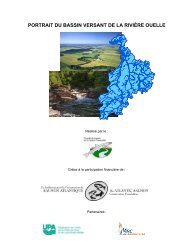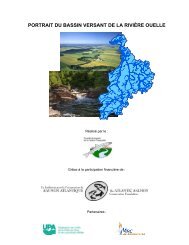Little Sackville River Digger Log Installation 2009 - The Atlantic ...
Little Sackville River Digger Log Installation 2009 - The Atlantic ...
Little Sackville River Digger Log Installation 2009 - The Atlantic ...
You also want an ePaper? Increase the reach of your titles
YUMPU automatically turns print PDFs into web optimized ePapers that Google loves.
Electro-Fishing Survey on <strong>Little</strong> <strong>Sackville</strong> <strong>River</strong> July 2 <strong>2009</strong><br />
Crew Leader: Colin O’Neil<br />
Crew: Tim Kelly, John‐William Brunner, Cyndi LeBlanc, Kate MacPhee<br />
Water Quality<br />
pH: 7.7<br />
Water Temperature: 19.5<br />
Weather: Cloudy<br />
Equipment: Smith‐Root Model 15 POW Electrofisher<br />
Voltage Setting: 300<br />
Mode Switches: J‐5<br />
Table 2. Electrofishing survey area<br />
Electrofishing Section Average <strong>River</strong> Width* Electrofishing Section<br />
Length<br />
Electrofishing Section<br />
Area<br />
6.34m 151.83m 962.6m 2 (9.93 Units)<br />
*Average width taken from 5 representative width measures over the area<br />
Table 3. Fish Caught by Number and Density per Unit<br />
Species Population Density (Units)<br />
<strong>Atlantic</strong> salmon 48* 4.98<br />
Brook trout 1* 0.10<br />
American eel 53 5.50<br />
Creek chub 57* 5.92<br />
White sucker 33* 3.43<br />
Common shiner 2* 0.21<br />
*Only actual number of fish caught, population projection not possible<br />
<strong>The</strong> electrofishing survey was performed to establish a benchmark in order to help<br />
determine the effectiveness of restoration activities to be performed in this section of the <strong>Little</strong><br />
<strong>Sackville</strong> <strong>River</strong>. <strong>The</strong> electrofishing was performed over an area as listed in Table 2 and included<br />
a variety of habitat areas including pools, riffles and runs. <strong>The</strong> electrofished section was in the<br />
middle of the planned work area for this year, starting at the old digger log on Site 62<br />
(44.75728°N, 63.67418°W) and extending to 15 meters upstream of site 58 (44.757770°N,<br />
63.67580°W), just below the s‐turn. This area was picked as a representative sample of the<br />
entire <strong>2009</strong> work area.<br />
<strong>The</strong> electrofishing was performed using Zippen’s 1 removal method of population<br />
estimation with three sweeps. This method consists of electrofishing the sample area three<br />
times, counting the fish caught in each sweep then removing them from the sample area for the<br />
duration of the survey.<br />
1 Zippin, Calvin. “<strong>The</strong> Removal Method of Population Estimation.” Journal of Wildlife Management 22.1<br />
(1958): 82‐90<br />
25 | <strong>Digger</strong> <strong>Log</strong> <strong>Installation</strong> <strong>2009</strong>





